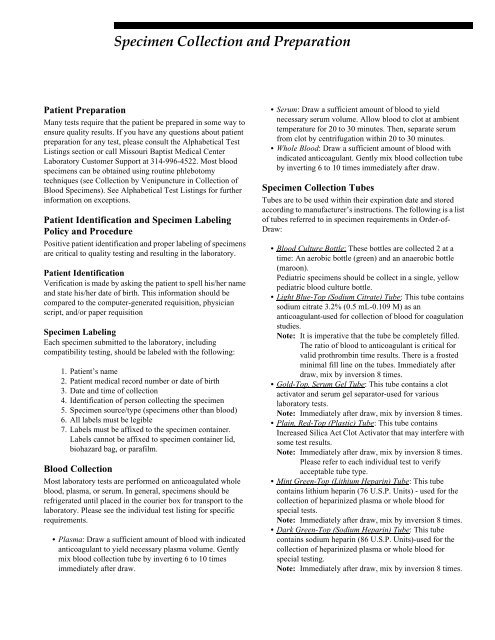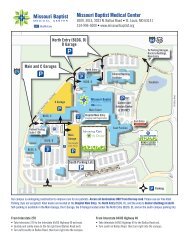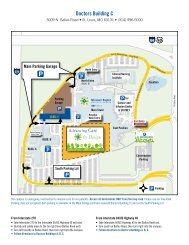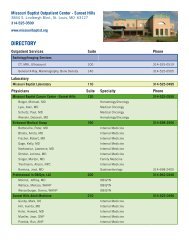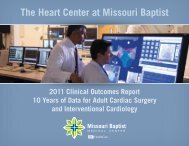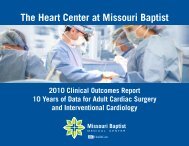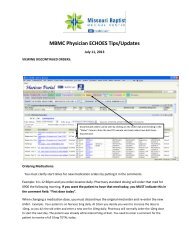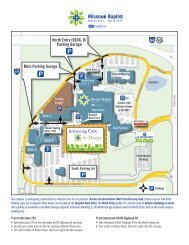Specimen Collection and Preparation.fm - Missouri Baptist Medical ...
Specimen Collection and Preparation.fm - Missouri Baptist Medical ...
Specimen Collection and Preparation.fm - Missouri Baptist Medical ...
Create successful ePaper yourself
Turn your PDF publications into a flip-book with our unique Google optimized e-Paper software.
<strong>Specimen</strong> <strong>Collection</strong> <strong>and</strong> <strong>Preparation</strong>Patient <strong>Preparation</strong>Many tests require that the patient be prepared in some way toensure quality results. If you have any questions about patientpreparation for any test, please consult the Alphabetical TestListings section or call <strong>Missouri</strong> <strong>Baptist</strong> <strong>Medical</strong> CenterLaboratory Customer Support at 314-996-4522. Most bloodspecimens can be obtained using routine phlebotomytechniques (see <strong>Collection</strong> by Venipuncture in <strong>Collection</strong> ofBlood <strong>Specimen</strong>s). See Alphabetical Test Listings for furtherinformation on exceptions.Patient Identification <strong>and</strong> <strong>Specimen</strong> LabelingPolicy <strong>and</strong> ProcedurePositive patient identification <strong>and</strong> proper labeling of specimensare critical to quality testing <strong>and</strong> resulting in the laboratory.Patient IdentificationVerification is made by asking the patient to spell his/her name<strong>and</strong> state his/her date of birth. This information should becompared to the computer-generated requisition, physicianscript, <strong>and</strong>/or paper requisition<strong>Specimen</strong> LabelingEach specimen submitted to the laboratory, includingcompatibility testing, should be labeled with the following:1. Patient’s name2. Patient medical record number or date of birth3. Date <strong>and</strong> time of collection4. Identification of person collecting the specimen5. <strong>Specimen</strong> source/type (specimens other than blood)6. All labels must be legible7. Labels must be affixed to the specimen container.Labels cannot be affixed to specimen container lid,biohazard bag, or parafilm.Blood <strong>Collection</strong>Most laboratory tests are performed on anticoagulated wholeblood, plasma, or serum. In general, specimens should berefrigerated until placed in the courier box for transport to thelaboratory. Please see the individual test listing for specificrequirements.• Plasma: Draw a sufficient amount of blood with indicatedanticoagulant to yield necessary plasma volume. Gentlymix blood collection tube by inverting 6 to 10 timesimmediately after draw.• Serum: Draw a sufficient amount of blood to yieldnecessary serum volume. Allow blood to clot at ambienttemperature for 20 to 30 minutes. Then, separate serumfrom clot by centrifugation within 20 to 30 minutes.• Whole Blood: Draw a sufficient amount of blood withindicated anticoagulant. Gently mix blood collection tubeby inverting 6 to 10 times immediately after draw.<strong>Specimen</strong> <strong>Collection</strong> TubesTubes are to be used within their expiration date <strong>and</strong> storedaccording to manufacturer’s instructions. The following is a listof tubes referred to in specimen requirements in Order-of-Draw:• Blood Culture Bottle: These bottles are collected 2 at atime: An aerobic bottle (green) <strong>and</strong> an anaerobic bottle(maroon).Pediatric specimens should be collect in a single, yellowpediatric blood culture bottle.• Light Blue-Top (Sodium Citrate) Tube: This tube containssodium citrate 3.2% (0.5 mL-0.109 M) as ananticoagulant-used for collection of blood for coagulationstudies.Note: It is imperative that the tube be completely filled.The ratio of blood to anticoagulant is critical forvalid prothrombin time results. There is a frostedminimal fill line on the tubes. Immediately afterdraw, mix by inversion 8 times.• Gold-Top, Serum Gel Tube: This tube contains a clotactivator <strong>and</strong> serum gel separator-used for variouslaboratory tests.Note: Immediately after draw, mix by inversion 8 times.• Plain, Red-Top (Plastic) Tube: This tube containsIncreased Silica Act Clot Activator that may interfere withsome test results.Note: Immediately after draw, mix by inversion 8 times.Please refer to each individual test to verifyacceptable tube type.• Mint Green-Top (Lithium Heparin) Tube: This tubecontains lithium heparin (76 U.S.P. Units) - used for thecollection of heparinized plasma or whole blood forspecial tests.Note: Immediately after draw, mix by inversion 8 times.• Dark Green-Top (Sodium Heparin) Tube: This tubecontains sodium heparin (86 U.S.P. Units)-used for thecollection of heparinized plasma or whole blood forspecial testing.Note: Immediately after draw, mix by inversion 8 times.
• Pearl-Top (K 2 EDTA Gel) Tube: This tube contains K 2EDTA as an anticoagulant with a polymer gel separator.Note: Immediately after draw, mix by inversion 8 times.• Lavender-Top (EDTA) Tube: This tube contains EDTA(K 2 EDTA 7.2 mg) as an anticoagulant-used for mosthematology tests (CBC, etc.) procedures <strong>and</strong> Blood Banktest requests.Note: Immediately after draw, mix by inversion 8 times.• Grey-Top (Potassium Oxalate/Sodium Fluoride) Tube:This tube contains potassium oxalate (4 mg) <strong>and</strong> sodiumfluoride (5 mg) as a preservative-used to preserve glucosein whole blood, lactic acid, <strong>and</strong> other tests.Note: Immediately after draw, mix by inversion 8 times.• Royal Blue-Top Tube: There are 2 types of royal blue-topMonoject tubes-1 with the anticoagulant EDTA <strong>and</strong> theother plain. These are used for collection of whole bloodor serum for trace element analysis. Refer to individualmetals in individual test listings to determine tube typenecessary.Note: Immediately after draw, mix by inversion 8 times.• Yellow-Top (ACD) Tube: This tube contains ACD(solution B) trisodium citrate; citric acid; dextrose-usedfor the collection of whole blood for special tests.Note: Immediately after draw, mix by inversion 8 times.• Special <strong>Collection</strong> Tubes: Some tests require specifictubes for proper analysis. Please call <strong>Missouri</strong> <strong>Baptist</strong><strong>Medical</strong> Center Laboratory Customer Support at 314-996-4522 prior to patient draw to obtain correct tubes for metalanalysis or other tests as identified in individual testlistings.• Blood Gas Syringe: This syringe contains lithium heparin<strong>and</strong> is for the collection of arterial <strong>and</strong> cord blood gases.When a venipuncture is technically difficult, or the patient is atrisk of complications from blood loss (eg, pediatric or intensivecare patients), smaller volumes may be necessary. When patientconditions do not m<strong>and</strong>ate reduced collection volumes, we askthat our clients submit preferred volume to facilitate rapid, costeffective, reliable test results. Submitting less than preferredvolume may negatively impact quality of care by slowing TAT,increasing the h<strong>and</strong>s-on personnel time required to perform test.<strong>Missouri</strong> <strong>Baptist</strong> <strong>Medical</strong> Center Laboratory makes everypossible effort to successfully test the patient’s specimen. If youhave concerns about submitting a specimen for testing, pleasecall <strong>Missouri</strong> <strong>Baptist</strong> <strong>Medical</strong> Center Laboratory at 314-996-4522. Our staff will discuss the test <strong>and</strong> specimen you haveavailable. While in some cases specimens are obviouslyinadequate for desired test, in other cases, testing can beperformed using alternative techniques.<strong>Specimen</strong> VolumeThe <strong>Specimen</strong> Required section of each test includes thepreferred specimen container to be submitted for testing. Whenthe container is a tube of blood, it is implied that a completelyfilled tube is preferred. The preferred specimen requirementshave been established to optimize testing <strong>and</strong> allow thelaboratory to quickly process specimen containers, presentcontainers to instruments, perform test, <strong>and</strong> repeat test, ifnecessary. Many of our testing processes are fully automated;<strong>and</strong> as a result, this volume allows h<strong>and</strong>s-free testing <strong>and</strong> ourquickest turnaround time (TAT). Since patient values arefrequently abnormal, repeat testing, dilutions, or otherspecimen manipulations often are required to obtain a reliable,reportable result. Our preferred specimen requirements allowexpeditious testing <strong>and</strong> reporting.


